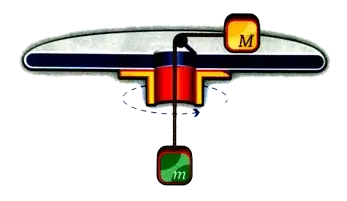A circular horizontal table spins around its axis of rotation with a constant angular speed. It completes one revolution in 2 seconds. An object whose mass is $M = 0.8 \ \text{kg}$ is placed on the table and is connected with a string to some weight with the mass $m = 0.16 \ \text{kg}$. Coefficient of friction between the object and the table is $0.1$. Determine for the following radii whether the body will remain at rest with respect to the table, or will move towards the center of the table or will move to the edge of the table: $40\text{cm}$, $25\text{cm}$, $15\text{cm}$, $8\text{cm}$.

I thought to solve it like that:
The only force acting on the weight is gravity, and it is the same force which is pulling the object (string tension, if we neglect string's mass) - $mg \approx 1.6\ \text{N}$. This force together with friction are the components of the centripetal force. My intuition says that the centripetal force which is needed to keep the object at rest with respect to the table should be: $MV^2/R$. Knowing the period, we can calculate the speed: $2\pi R/T=V$. So the centripetal force needed is $MR 4\pi ^2/T^2 = MR \pi ^2 \approx 8R$. The friction here may act on the object in any direction, as I understand. It depends on the radius. But the max friction value is: $f_{s, max} = \mu N = \mu Mg = 0.1 M \approx 0.8\ \text{N}$.
Case 1: ($R=0.4\ \text{m}$): The centripetal force needed is $\approx 3.2\ \text{N}$. However the pull force of the little weight is $1.6\ \text{N}$ and the max friction is $0.8\ \text{N}$ which is not enough to keep the object spinning with the table, and therefore, it will just move towards the edge of the table and will eventually fall (Pull force and friction force are directed to the center of the table).
Case 2: ($R = 0.25\ \text{m}$): The centripetal force needed is $\approx 2\ \text{N}$. The pull force ($1.6\ \text{N}$) and the friction ($0\leq f \leq f_{s,max}$) which equals to $0.4\ \text{N}$ are enough to keep the object at rest with respect to the table (Pull force and friction force are directed to the center of the table).
Case 3: ($R = 0.15\ \text{m}$): The centripetal force needed is $\approx 1.2\ \text{N}$. The pull force ($1.6\ \text{N}$) is much bigger than the needed centripetal force, but the friction in this case is opposing the body movement towards the center of the table. Therefore, the friction force vector is in the opposite direction ($\vec f = -0.4\ \text{N}$). So the object will rest with respect to the table here as well.
Case 4: ($R = 0.08\ \text{m}$): The centripetal force needed is $\approx 0.64\ \text{N}$. The pull force ($1.6\ \text{N}$) is much bigger and the friction force acting on the object in the opposite direction is not enough to stop it from moving towards the center as a result of the string pull ($\vec F_{pull} - \vec f = 1.6 - 0.8 = 0.8\ \text{N}$). Therefore, the string will move towards the center.
To sum up, the friction is what helps expanding the "rest radius range". If there was no friction, then the "rest radius range" will become narrow and will basically be some explicit radius ($F_{pull} / F_{needed\ centripetal} = 1.6 / 8 R = 1 \Rightarrow R \approx 0.2$). Any other radius which will be bigger than that will cause the body to fly off the table. Any radius smaller will cause the body to move towards the center of the table.
I wanted to make sure that I'm right in my answers.